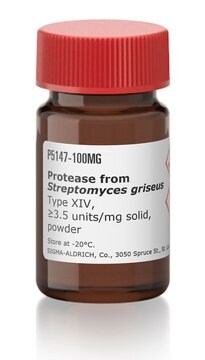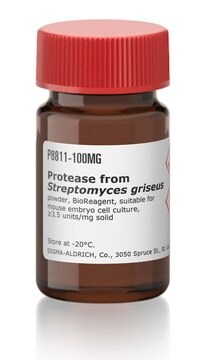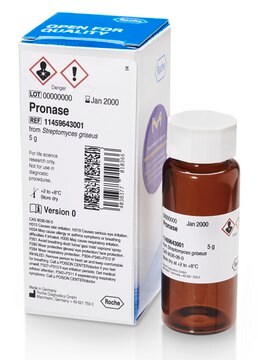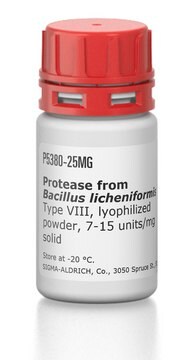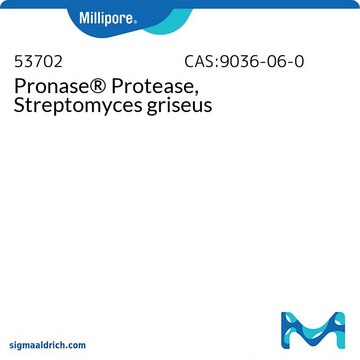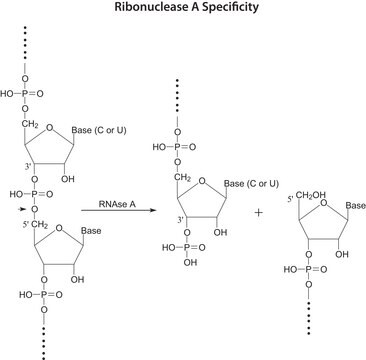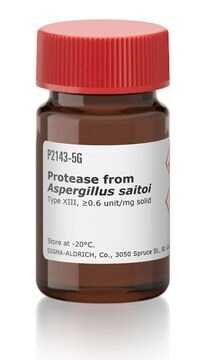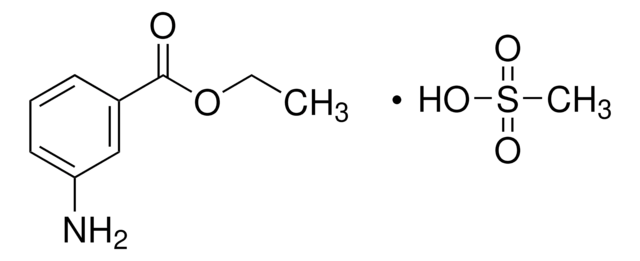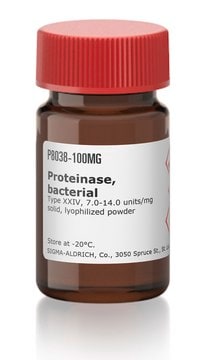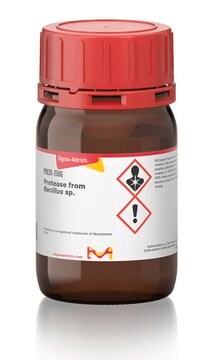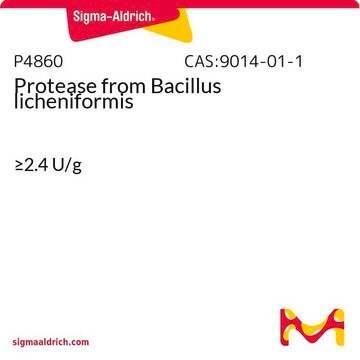P6911
Protease from Streptomyces griseus
BioReagent, DNase, RNase, and nickase, none detected (No RNase.)
Synonym(s):
Actinase E, Pronase E
Sign Into View Organizational & Contract Pricing
All Photos(1)
About This Item
CAS Number:
EC Number:
MDL number:
UNSPSC Code:
12352204
eCl@ss:
32160410
NACRES:
NA.21
Recommended Products
grade
for molecular biology
Quality Level
product line
BioReagent
form
powder
mol wt
monomer ~20 kDa
concentration
≥4 unit/mg
solubility
water: 5-20 mg/mL
foreign activity
DNase, RNase, and nickase, none detected (No RNase.)
storage temp.
−20°C
Looking for similar products? Visit Product Comparison Guide
General description
A mixture of at least three proteolytic activities including an extracellular serine protease. In general, serine proteases display a wide range of substrate specificities, which are believed to be mediated by an active site composed of one Asp, one His, and a Ser residue in the molecule. This enzyme prefers to hydrolyze peptide bonds on the carboxyl side of glutamic or aspartic acid.
Specificity
A mixture of at least three proteolytic activities including an extracellular serine protease. In general, serine proteases display a wide range of substrate specificities, which are believed to be mediated by an active site composed of one Asp, one His, and a Ser residue in the molecule. This enzyme prefers to hydrolyze peptide bonds on the carboxyl side of glutamic or aspartic acid.
Application
Protease is typically used in nucleic acid isolation procedures in incubations of 0.5-3.0 hours supplemented with 0.2% sodium dodecyl sulfate and 10 mM EDTA.
Suitable for:
- Nucleic acid isolation procedures in incubations
- Degrade protein during nucleic acid purification
- Proteolysis of insoluble protein
- Structural protein studies
This enzyme is more active at a higher pH range than the known alkaline protease, showing the proteolytic activity even in 0.2N NaOH solution. This enzyme is useful for proteolysis of insoluble protein and for structure investigation of protein.
Physical properties
Completely inactivated by heating above 80 °C for 15-20 minutes.
Unit Definition
One unit will hydrolyze casein to produce color equivalent to 1.0 μmole (181 μg) of tyrosine per min at pH 7.5 at 37 °C (color by Folin-Ciocalteu reagent).
Preparation Note
Collected from culture broth of S. griseus.
Analysis Note
The protease is incubated for 10 minutes at pH 7.5 at 37°C in a 6 ml reaction volume containing 0.54% casein and 0.041 M potassium phosphate buffer. The reaction is stopped by the addition of 5.0 ml of 0.11 M trichloroacetic acid.
Other Notes
This protease is completely inactivated by heating above 80°C for 15-20 minutes. This enzyme is more active at a higher pH range, showing the proteolytic activity even in 0.2N NaOH solution.
Signal Word
Danger
Hazard Statements
Precautionary Statements
Hazard Classifications
Eye Irrit. 2 - Resp. Sens. 1 - Skin Irrit. 2 - STOT SE 3
Target Organs
Respiratory system
Storage Class Code
11 - Combustible Solids
WGK
WGK 2
Flash Point(F)
Not applicable
Flash Point(C)
Not applicable
Personal Protective Equipment
dust mask type N95 (US), Eyeshields, Gloves
Choose from one of the most recent versions:
Already Own This Product?
Find documentation for the products that you have recently purchased in the Document Library.
Customers Also Viewed
D Y Yum et al.
Bioscience, biotechnology, and biochemistry, 58(3), 470-474 (1994-03-01)
SAP, an extracellular alkaline serine protease produced by Streptomyces sp. YSA-130, was purified to homogeneity by CM-Sephadex column chromatography and crystallization. The enzyme was a monomeric protein with a molecular weight of 19,000 as estimated by SDS-PAGE and gel filtration.
N Yoshida et al.
Journal of biochemistry, 104(3), 451-456 (1988-09-01)
A protease was purified 163-fold from Pronase, a commercial product from culture filtrate of Streptomyces griseus, by a series of column chromatographies on CM-Toyopearl (Fractogel), Sephadex G-50, hydroxyapatite, and Z-Gly-D-Phe-AH-Sepharose 4B using Boc-Ala-Ala-Pro-Glu-pNA as a substrate. The final preparation was
Hyun-Ju Cho et al.
Disease models & mechanisms, 12(5) (2019-05-03)
DYRK1A is a major causative gene in Down syndrome (DS). Reduced incidence of solid tumors such as neuroblastoma in DS patients and increased vascular anomalies in DS fetuses suggest a potential role of DYRK1A in angiogenic processes, but in vivo
P Bressollier et al.
Applied and environmental microbiology, 65(6), 2570-2576 (1999-05-29)
Streptomyces strain K1-02, which was identified as a strain of Streptomyces albidoflavus, secreted at least six extracellular proteases when it was cultured on feather meal-based medium. The major keratinolytic serine proteinase was purified to homogeneity by a two-step procedure. This
Aline C Habison et al.
PLoS pathogens, 13(9), e1006555-e1006555 (2017-09-15)
Many pathogens, including Kaposi's sarcoma herpesvirus (KSHV), lack tractable small animal models. KSHV persists as a multi-copy, nuclear episome in latently infected cells. KSHV latency-associated nuclear antigen (kLANA) binds viral terminal repeat (kTR) DNA to mediate episome persistence. Model pathogen
Our team of scientists has experience in all areas of research including Life Science, Material Science, Chemical Synthesis, Chromatography, Analytical and many others.
Contact Technical Service